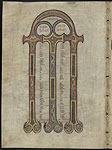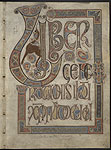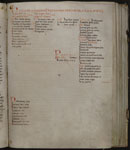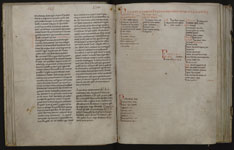Books of the Bible
During the Middle Ages, books of the Bible were used in worship and personal study. Western European manuscripts kept in the National Library of Russia reflect all the functions that were performed by the Christians' main book in different periods of the Middle Ages.
In the early Middle Ages, the complete Bible is rarely produced. The Gospels were copied most often, they make up 43% of all extant Biblical books, created before the 9th century. The Gospels of this period were adorned with portraits of the Evangelists and their symbols, decorative frames and ornamental initials. Created at the end of the 8th century in Britain, the so-called Insular Gospel book highly impresses with splendid colours and ornamental motifs. The illumination of the manuscript consists of 12 Canon Table Arcades and the four initial pages with large ornamented initials at the start of each Gospel. Such lavishly decorated opening pages are a characteristic feature of early Scottish and British Gospels. The first letters on the initial pages were embellished with interlacing patterns, they were the size of a half sheet or a sheet. The following letters were made in different colours, and they gradually diminish in size from the first to the last line of the page.Multi-volume, large format, altar Bible were created for worship in the monastic scriptorium during the 11th-12th centuries. The NLR stores the two-volume Bible of the South German Weissenu Monastery, which includes a written inventory of monastic books.
According to the inventory, the total number of books, which had a monastery in the late 12th century, was 79 volumes. The inventory consists of two parts. The first lists books intended for personal readings of the monks: the works of the Church Fathers and pious literature. The second part contains service books kept in the church. The two volumes of the Bible itself occupy the first place in the list of the liturgical books (“Publiothecae duae”).
At the turn of the first and second millennia, the books of St. Scripture became the object of intense study. Based on the writings of the Church Fathers, Walafrid Strabo († 849), Anselm Laonsky († 1117) and their disciples created commentaries to all the biblical books (ie. glossa ordinaria). A folio from the 12th century Gospel with comments look as follows: the Biblical text written in a large script is placed in the middle; annotations are written on margins to the left and right of it; under the evangelical lines are interlinear comments in small letters. Unlike the altar Bibles intended for the liturgy, Bibles with Comments were designed for studying in the monastic and cathedral schools.At the end of 12th century, in Europe, the first European universities appeared. In Bologna, Montpellier, Paris, Oxford, and then in other European cultural centers, the independent corporations of teachers and students formed a new type of stage-by-stage learning, unknown to the ancient world.
The Theological Faculty at the University of Paris was recognized as the leader in matters of faith. No coincidence that in the early thirteenth century, the Paris theologians undertook work on the standardization of the Bible. They used Alcuin's improved text of the Latin Vulgate translation as a basis. In the Bibles created before the 13th century, researchers count to more than two hundred different orders of the biblical books. The contemporary Bibles follow the arrangement as given in the Paris Bibles (or the so-called University Bibles) that appeared in the early 13th century. The number of prefaces has been reduced: out of more than 500, Parisian theologians have left 64 St. Jerome's Prefaces. Since the 13th century, the biblical books have been divided into chapters and have been provided with headings. At the end, there were alphabetical lists of biblical figures with brief comments.
The Paris Bibles were the single-volume books of small size, written in tiny Gothic script on pages of very thin parchment. They became very popular and widespread. Before the 13th century, the full text Bibles were produced relatively rare, one-volume Bibles occurred even rarer. The Psalms and the Gospels were copied most often. Manuscripts with Comments contain, as a rule, no more than one or two books of the Bible. The Paris Bibles afforded scholars and students a chance to buy Bibles complete in one volume at a reasonable price. It was not cheap but less expensive then before. These books make it easier to study the Bible, because they contain scientific, in the modern sense of the word, aids: a table of contents and an annotated index of names. The Paris Bibles were very convenient for mendicant orders founded in the early 13th century: the Order of St. Francis and the Order of St. Dominica. The monks of the orders had the right to preach and to perform the sacraments. A portable volume could fit easily in a monastic bag, and its reference tools helped to quickly find a desired passage for sermons. The Psalter was the first prayer book of Christians. Psalms and individual verses from the Psalter were used for the liturgy, in the Books of Hours and prayer books. The National Library of Russia possesses a magnificent Psalter, illuminated with gold, that was created in France in the 13th century. The Psalms were written in a Gothic script. At the turn of the 12th and 13th centuries, the Romanesque style was replaced by the Gothic one in architecture and sculpture. The style also extended to the so-called small arts, which included calligraphy and book illumination. In the books of that time, the round and easily readable Carolingian script gave way to the tall, narrow Gothic writing. The exhibited Psalter is inscribed in such sharp letters, difficult to read.During the 13th-14th centuries, the number of literate people , especially the citizens, increased. For lay people, who would like to become better acquainted with the Bible, there produced its heavily illustrated simpler versions in Latin and the vernacular. These were the so-called Paupers' Bible (Biblia pauperum) for semi-literate people: moralized Bibles (Bible moralisée), historical Bibles (Bible Historiale), Mirrors of Human Salvation (Speculum humanae salvationis).
In the mid-14th century France, there was created a magnificent illuminated copy of the "Bible Historiale" - an author's paraphrase of the late 12th century work "Historia Scholastica" by Petrus Comestor, which retold sacred history. Comestor's Latin text was translated into the French language by Guillaume de Moulins. The large parchment manuscript is decorated with miniature: the "Bible Historiale" opens with a frontispiece, representing the universe in allegorical form. The spiritual world - the Holy Trinity and the nine angelic choirs are shown at the top of the miniatures. The cosmogonic model of the earth is placed at the lower part. In the centre of the miniature are three columns of text, each of which begins with historiated initials. The author of the "Bible Historiale" Guillaume de Moulins standing before the Virgin Mary is depicted in the first initial, the middle initial contains the image of the author of the original text Petrus Comestor, the third represens St. Jerome giving his translation of the Bible to the Pope. At the bottom, left and right are the coats of arms of the royal house of Navarre. The book bears owner's records of Queen of Navarre Jeanne d'Albret, her son, the future king of France Henry IV, and his wife, Margaret of Valois. Unlike the luxury parchment copy of the "Bible Historiale", the illuminated paper manuscript with "The Mirror of Human Salvation" , created for the educated citizens, looks very modest. The book is the work of the moralistic literary genre of Mirrors. There were "Mirrors of Princes", "Mirrors of the Church", and so on. The poetic text of "The Mirror of Human Salvation" narrates sacred history from the Fall to the Ascension of Christ. Depicted on the miniatures at the top of the folios (in the left side of double-pages), episodes of the New Testament are related to the Old Testament scenes on the right side of double-pages. Thus, the bearing of the cross of Christ is related to the story of Abraham and his son Isaac. God told Abraham to sacrifice his beloved son to see how Abraham obeys his will. The miniature shows Abraham carrying a torch to light the fire with, and his son Isaac with the wood. But at the last moment, an angel stayed Abraham's hand. So, Christ allowed Himself to be crucified at his Father's will, sacrificed himself for the sake of all mankind, but rose from the dead on the third day. In the 14th century, the separate books of the Bible and the entire Bible were translated into national languages. Known is an English translation of the Bible, made in 1380, in the surroundings of John Wycliffe (1320 / 1324-1384). In the Netherlands, at the end of 14th century, among the "Morden Devotion" movement (Devotio moderna), there was advanced an idea that all nations, including the Dutch, have the right to read the Bible in their own languages. The main monastery of the «Modern Devotion» at Windesheim had two libraries: one contained Latin books for the monks, the other held books in the vernacular for the lay brothers. The Dutch books library was in charge of Canon Jan Scutken Canon († 1423). During meals, Scutken read passages from the Gospels, translated him into Dutch, to the lay brothers. The Dutch translation of the four Gospels were made up of these extracts.The National Library of Russia keeps two manuscript Gospels in translation made by Jan Scutken. They belonged to nunneries of the Congregation of Windesheim. The one kept in the Convent of Saint Agnes in Haarlem carries a record proving the accuracy of Jan Scutken's translation, 'There ends the Gospel of St. Matthew in Dutch, which very accurately conveys the holiness [of the book]'. The last page bears a scribe's inscription indicating the date of creating the manuscript - 1476.









